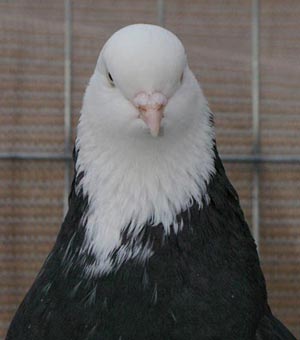

|

| Baldheads - "Thumb" Markings | Grease Quill Examples |
| Eye Color Examples | Common Colors & Patterns |
| Head/Front View Examples |
 |
Front View - Example # 1 This self has won her class many, many times and is an example of a good eye, beak and head setting -- not the very best of course, but a good example. Notice the beak location and eye settings are balanced within the shape of the head which in turn blends nicely into the neck. They appear as one together rather than a bird with a head and neck distinguishing between one another. *Text and photo courtesy of Brian McCormick |
 |
Front View - Example # 2 This hen has a nice feminine head and proportionate beak setting in relation to the skull shape and size. In this photo you can see the bird is looking slightly downward which again illustrates that when the shape of the skull is in good order, the eyes are hard to see straight on. *Text and photo courtesy of Brian McCormick |
 |
Front View - Example # 3 This bird possesses a borderline overbalanced front view shape, yet is very pleasing in all other aspects. The lower cheeks are full and the frontal flows nicely into the top skull and then blending into the neck. Notice the eyes again are nearly non-visible. My assessment of "borderline overbalanced" noted in the above sentence is based on the overall height of the skull which is most likely thick, short feathering. I would like to see this in more of my own birds, but just a little flatter on the top -- not much, but just a little to remove some of the 'roundness'. *Text and photo courtesy of Brian McCormick |
 |
Front View - Example # 4 This bird demonstrates the lack of frontal skull width which is covered up by excessive feathering to create the illusion of a bold frontal, which in this case is simply all feathering. The vector of the eyes to the beak shows this. The back of the head posseses again, too much feathering which falls into the "power" catagory. The neck feathering is too long and profuse as well as 'curling' or 'whiskering' . This in my opinion is a totally unbalanced head and neck setting. *Text and photo courtesy of Brian McCormick |
 |
Front View - Example # 5 Here is a good example of a "pinched" face bird or better yet an almost emaciated appearance most likely a sign of too much inbreeding. The eyes are angled inward to a degree that nearly put the vector plane of the two together near the waddle instead of at the tip of or past the beak which would be proper. The bird lacks skull substance from the frontal through to the back of the head and as you can see is a good example of a bird with a "head on a neck". *Text and photo courtesy of Brian McCormick |